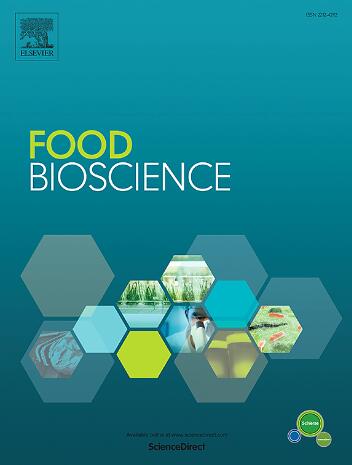Different powder particle size combined with ultrasound-assisted enzymolysis: Effects on physicochemical, functional and antioxidant properties of Acheta domesticus protein hydrolysate
IF 5.9
1区 农林科学
Q1 FOOD SCIENCE & TECHNOLOGY
引用次数: 0
Abstract
This study prepared Acheta domesticus protein hydrolysate (ADPH) using house cricket powder with different particle sizes and ultrasound-assisted enzymolysis. The results demonstrated that using of ultrafine powder and ultrasonic treatment during enzymatic hydrolysis significantly increased the amino acid content of the ADPH and rendered its microstructure more porous and loose. Structural analysis (Fourier transform infrared spectroscopy and fluorescence spectroscopy) revealed that ultrafine powder and ultrasonic treatment further disrupted the secondary and tertiary structures of cricket protein, diminished α-helix/β-turn content, and reduced the surface hydrophobicity of the hydrolysate. In terms of functional properties, ultrafine powder and ultrasonic treatment enhanced the foaming and emulsifying capabilities of the ADPH, while improving its thermal stability, crystallinity, and antioxidant activity. Moreover, the combined application of the two methods during enzymatic hydrolysis significantly enhances the functional properties and antioxidant activity of ADPH. These findings suggest that combination of ultrafine powder and ultrasonic treatment is a promising method for improving the physicochemical and antioxidant properties of hydrolysate.
不同粉体粒度结合超声辅助酶解:对国产Acheta蛋白水解物理化、功能及抗氧化性能的影响
以不同粒径的蟋蟀粉为原料,采用超声辅助酶解法制备了国产Acheta水解蛋白(ADPH)。结果表明,在酶解过程中使用超细粉末和超声波处理可显著提高ADPH的氨基酸含量,使其微观结构更加多孔和疏松。结构分析(傅里叶变换红外光谱和荧光光谱)表明,超细粉末和超声波处理进一步破坏了蟋蟀蛋白的二级和三级结构,降低了α-螺旋/β-转含量,降低了水解产物的表面疏水性。在功能性能方面,超细粉末和超声处理增强了ADPH的发泡和乳化能力,同时提高了ADPH的热稳定性、结晶度和抗氧化活性。此外,两种方法在酶解过程中的联合应用显著提高了ADPH的功能特性和抗氧化活性。研究结果表明,超细粉与超声联合处理是改善水解产物理化性能和抗氧化性能的一种很有前途的方法。
本文章由计算机程序翻译,如有差异,请以英文原文为准。
求助全文
约1分钟内获得全文
求助全文
来源期刊

Food Bioscience
Biochemistry, Genetics and Molecular Biology-Biochemistry
CiteScore
6.40
自引率
5.80%
发文量
671
审稿时长
27 days
期刊介绍:
Food Bioscience is a peer-reviewed journal that aims to provide a forum for recent developments in the field of bio-related food research. The journal focuses on both fundamental and applied research worldwide, with special attention to ethnic and cultural aspects of food bioresearch.
 求助内容:
求助内容: 应助结果提醒方式:
应助结果提醒方式:


